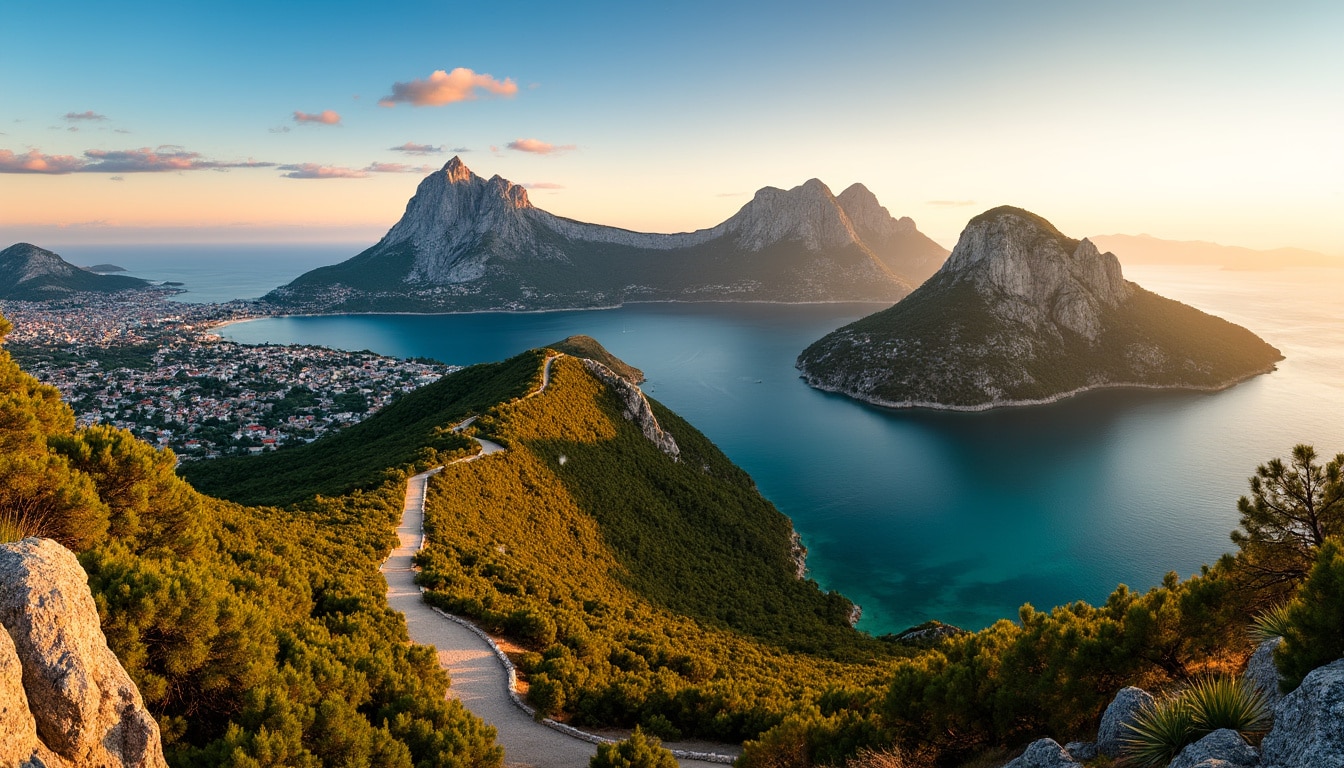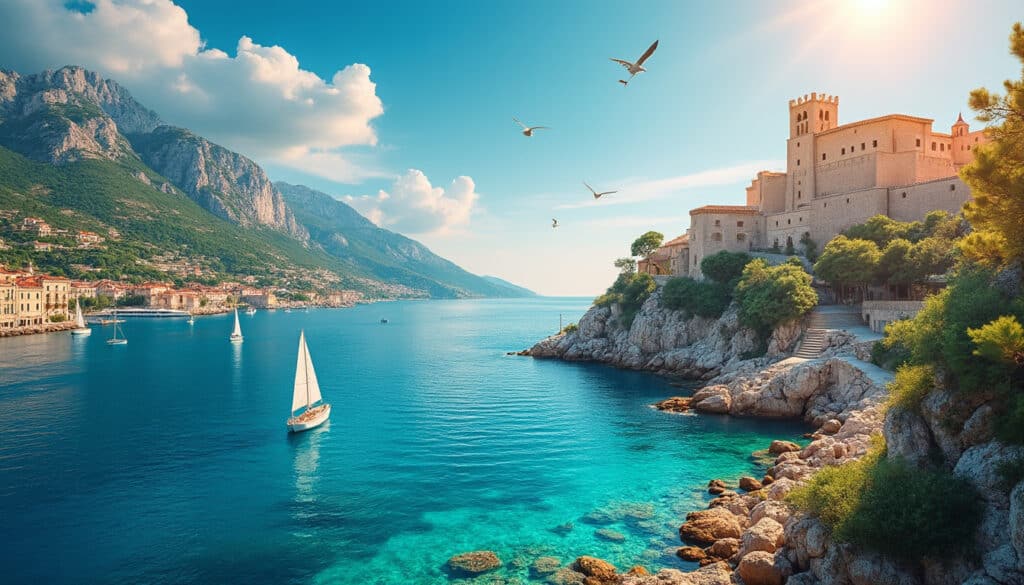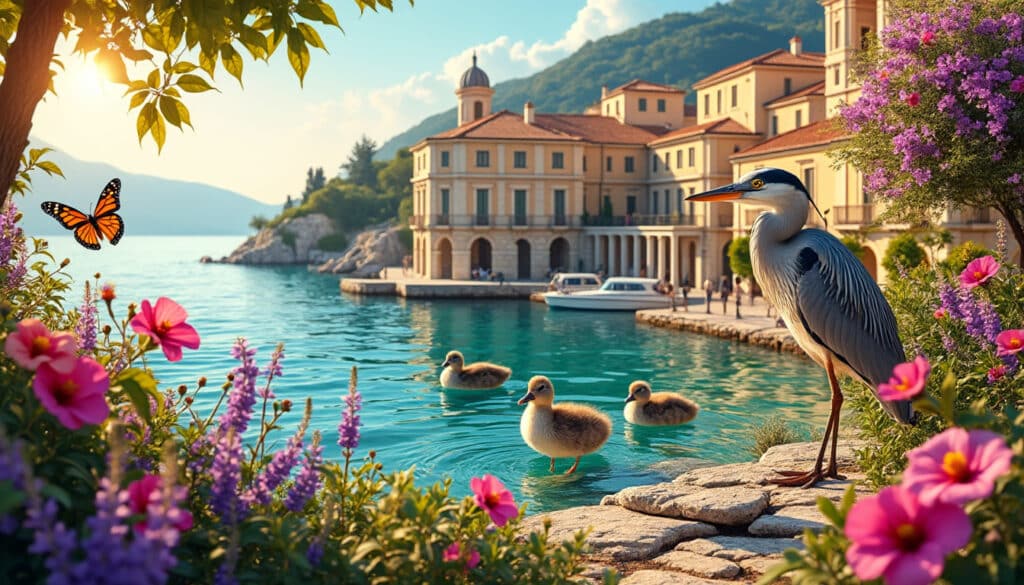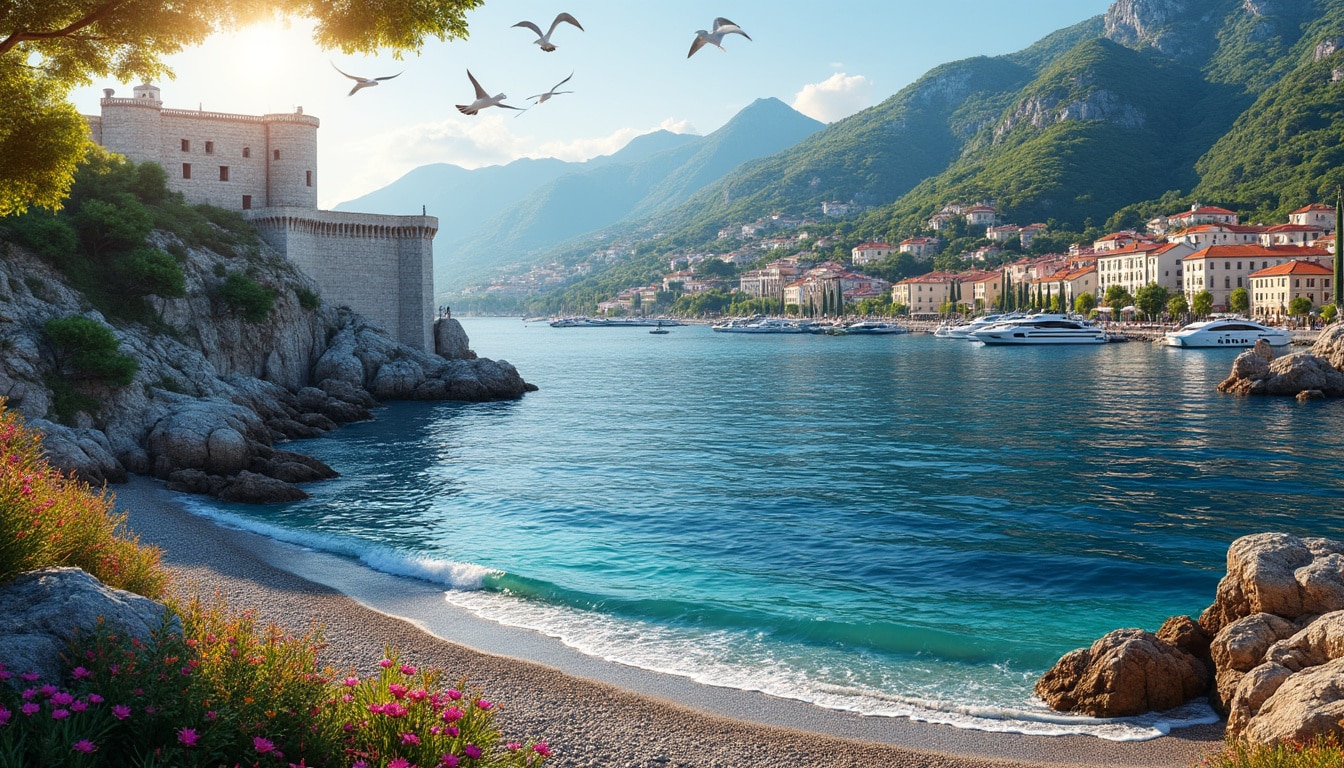Split, a city nestled along the Adriatic Coast in Croatia, is a remarkable blend of natural beauty and historical allure. Known for its distinct geographic features, Split offers an ideal location that harmoniously balances the grandeur of ancient architecture with stunning landscapes. Surrounded by mountains, beaches, and islands, Split’s topography plays a significant role in its cultural and economic development. This article explores the unique geographical features of Split, revealing how they contribute to the city’s charm and functionality. From the Marjan Peaks to the historic Diocletian’s Palace, each feature tells a story of history, culture, and nature.
Marjan Peaks: The Lush Green Haven
Located on the western tip of Split’s peninsula, the Marjan Hills provide not only a verdant retreat for locals and tourists but also act as a green lung for the city. This forest park covers a large portion of the peninsula, rising to a height of 178 meters above sea level. The Marjan Peaks, draped in dense Mediterranean woodlands, offer panoramic views of the surrounding azure sea and distant islands, making it a must-visit for nature lovers and hikers.
The significance of the Marjan Peaks extends beyond their natural beauty. They have historically been a site for religious reflection and activity. Many chapels and churches were built here in the past, adding a layer of spiritual significance. Today, these historical structures still stand amidst the foliage, providing picturesque spots for introspection and photography.
- 🌳 Marjan Forest Park: A sprawling green space perfect for outdoor activities and relaxation.
- 🕍 Historic Chapels: Visit sacred sites nestled within the forest.
- 🥾 Hiking Trails: Well-maintained paths offering various levels of difficulty for hikers.
Marjan is not just about the land, but also the sea. Around its base are several beautiful beaches such as Kašjuni Beach, which is popular for sunbathing and swimming. These beaches are some of the best in Split and are easily accessible, providing a refreshing contrast to the urban landscape. The harmony of land and sea makes Marjan Peaks a special feature that enhances Split’s geographical diversity.

The Cultural Significance
Beyond its natural allure, the Marjan Hills play a vital role in the cultural identity of Split. Locals celebrate various festivals and events at Marjan throughout the year, bringing communities together. The efforts to preserve and maintain this natural gem are crucial, as it serves as a place for recreation, reflection, and community engagement.
Efforts to conserve Marjan are evident in initiatives that promote the park as a center for environmental education. Local associations often organize tours and educational programs focusing on the local flora and fauna, as well as the history and cultural heritage associated with the area.
The Coastal Charms: Adriatic Waves and Split’s Islands
Stretching along the shimmering Adriatic Sea, the coastline of Split is an epitome of picturesque beauty and maritime significance. This coastal city is not only a gateway to some of the most beautiful Adriatic islands but also harbors an extensive maritime culture. The strategic location of Split has historically made it an important center for trade and navigation, influencing the development of the Port of Split Apparel industry and the city’s economy at large.
Split’s proximity to the Adriatic Waves is enhanced by its access to a host of breathtaking islands, including Brač, Hvar, and Vis. These islands are a short ferry ride from Split and offer exquisite experiences unique to the Adriatic culture. Each island boasts its distinct charm—from the sandy beaches and olive groves of Brač to the vibrant nightlife of Hvar and the quiet, historical lanes of Vis.
| 🏝️ Island | 🌿 Key Feature | 🚢 Accessibility |
|---|---|---|
| Brač | Golden Horn Beach | Frequent Ferries |
| Hvar | Lavender Fields & Nightlife | Regular Ferries and Speedboats |
| Vis | Historical Sites | Daily Ferry Service |
This seamless connectivity makes Split an ideal base for island hopping, attracting tourists globally. With its deep blue waters and enticing coastal stretches, the Adriatic Waters provide manifold opportunities for adventure sports, cruising, and relaxation. Visitors can indulge in a myriad of activities, from sailing and diving to exploring hidden coves and ancient ruins on the islands.
Economic and Cultural Impact
The Adriatic coast’s stunning beauty has fostered a robust tourism industry, which in turn supports local businesses and communities. The exchange between Levoze scenic landscapes and the bustling Port of Split Apparel industry illustrates Dalmatia’s integration of tradition with modernity. This synergy promotes a thriving economy, ensuring a sustainable environment for generations to come.
Dalmatian Heights: Mystique of the Mountains
Located to the north and northwest of Split, the Kozjak and Mosor mountain ranges serve as natural fortifications and offer dramatic backdrops to the cityscape. These “Dalmatian Heights” are major geographical features, providing a majestic setting that complements the coastal allure. Their rugged terrains are crisscrossed with trails that present ideal trekking opportunities, allowing both locals and adventurers to explore the tranquil heights above the bustling city below.
The Kozjak range, with its highest peak at 780 meters, offers relatively easy hikes with stunning vistas of Split and the Adriatic. On the other hand, the Mosor range, peaking at 1,330 meters, presents more challenging paths, rewarding trekkers with breathtaking views of the Split Channel and beyond.
- 🏔️ Kozjak Mountains: Easier trails with panoramic city views.
- ⛰️ Mosor Mountains: More challenging hikes with extensive vistas.
- 🌄 Adventure Sports: Opportunities for climbing, caving, and more.
The mountains are not just recreational havens; they have also witnessed historical events and bear remnants of past civilizations. Ancient pathways and fortifications hint at the strategic significance these ranges held for defending the Dalmatian territory. Today, they serve as a testament to the region’s storied past and continue to be appreciated for their untamed beauty and the challenge they pose to modern adventurers.
Environmental Preservation
Efforts to preserve these natural landscapes are crucial, as they are home to diverse flora and fauna. Conservation initiatives aim to protect these ecosystems while promoting responsible tourism. The mountains’ unspoiled beauty is a draw for eco-tourists and nature enthusiasts who wish to experience the splendor of the Dalmatian Heights while ensuring they remain pristine.
Riva Culture: Split’s Vibrant Urban Coastline
Running parallel to Split’s historical old town, the Riva promenade is an integral part of the city’s social and cultural life. This bustling waterfront area, framed by the stunning backdrop of the Adriatic, functions as both a leisurely space and a significant cultural hub. It’s where locals and visitors alike come to absorb Split’s dynamic atmosphere, enjoying its cafes, events, and the refreshing sea breeze.
The Riva is much more than a picturesque walkway. It hosts a variety of events throughout the year, including exhibitions, concerts, and festivals, integrating the vibrancy of Mediterranean life into the heart of Split. The area also offers splendid views of the architectural marvel of Diocletian’s Palace—the most iconic landmark in Split that speaks to the city’s rich Roman heritage.
- 🍴 Dining Experiences: From casual cafes to gourmet restaurants along the waterfront.
- 🎉 Events and Festivals: Live music, cultural performances, and local celebrations.
- 🕌 Architectural Views: Enjoy stunning vistas of Diocletian’s Stone and the surrounding architecture.
One of the most anticipated events is the Split Summer Festival, a cultural extravaganza featuring ballet, opera, and drama performances that transform the Riva into an open-air stage. This cosmopolitan flair showcases Split as a melting pot of tradition and contemporary culture.
Diocletian’s Influence
The presence of Diocletian’s Palace along the Riva further underscores the importance of this area in Split’s historical and cultural tapestry. Listed as a UNESCO World Heritage Site, the Palace dates back to the 4th century and remains a living monument where modern life mingles with ancient history.
Between the stunning coastal views and rich historical context, the Riva is an essential aspect of Split’s urban landscape, symbolizing the city’s connection to both its past and its present.
Bacvice Beach: A Slice of Croatian Leisure
No exploration of Split’s geography is complete without a visit to Bačvice Beach. Famous for its vibrant atmosphere and golden sands, Bačvice Beach embodies the quintessential Croatian beach experience. Located just a short walk from the city center, it is an essential spot for both sun-seekers and those interested in local culture.
Bačvice Beach is renowned for the traditional game of picigin, a sport played in shallow waters that reflects the local culture’s vibrancy and creativity. The beach’s environment promotes social interaction, inviting both locals and tourists to join in friendly games or simply relax and soak in the sun.
| 🏖️ Activity | 🌞 Highlight | ⏲️ Time |
|---|---|---|
| Picigin | Cultural Heritage Sport | All Year Round |
| Sunbathing | Warm Golden Sands | Spring to Early Autumn |
| Swimming | Crystal-clear Waters | All Year Round |
The beach is also a venue for numerous events and parties, especially in the summer, enhancing its reputation as a lively hub for entertainment. From beachside cafes to nightclubs, the area around Bačvice offers a plethora of options to experience the vibrant local scene.
Perfect for Families
Besides its energetic atmosphere, Bačvice is a family-friendly beach often bustling with children and parents. Its shallow waters make it ideal for younger swimmers, while nearby amenities ensure a comfortable visit. For those looking to explore Croatian leisure at its finest, Bačvice Beachwear is the perfect spot to immerse in the coastal culture.
Explore culinary delights near Bačvice for a true taste of local flavors.
FAQ: Discover More About Split’s Geographical Features
What is the best way to explore Split’s islands?
Ferries from the Port of Split offer regular services to nearby islands, making island hopping a convenient and popular choice.
Are there hiking routes suitable for beginners in Split’s mountains?
Yes, the Kozjak Mountains offer trails with varying degrees of difficulty, suitable for less experienced hikers.
How can I experience local culture on the Riva?
Visit during events like the Split Summer Festival or explore local dining options along the waterfront for a taste of Mediterranean life.
Is Bačvice Beach accessible year-round?
Yes, Bačvice is accessible throughout the year, offering various activities irrespective of the season.
What makes the Marjan Peaks unique?
The Marjan Peaks offer a unique combination of natural beauty and historical significance, with stunning views and ancient chapels dotted throughout.

With its intricate blend of lush landscapes, historical treasures, and picturesque beaches, Split is a captivating coastal city. Encompassing the spirit of Croatia’s Dalmatia region, Split draws tourists from around the world all year round. Amidst the backdrop of an…

Location and coordinates of Split
Nestled along the vibrant Adriatic Coast, the city of Split, Croatia, is a fascinating blend of historical grandeur and natural beauty. Its strategic location has made it a crossroads of cultures for millennia, a legacy still visible in its classical…

Split is more than a historical hub peppered with Roman relics; it’s a gateway to Croatia’s stunning natural wonders and rich wildlife. Travelers are drawn to Split not just for Dubrovnik’s white stones and ancient city walls, but for the…
Split, a picturesque city on Croatia’s Adriatic coast, serves as an idyllic haven for both its residents and visitors, offering an escape into a natural paradise. Home to several rivers, waterfalls, and water bodies, Split and its surrounding areas are…

